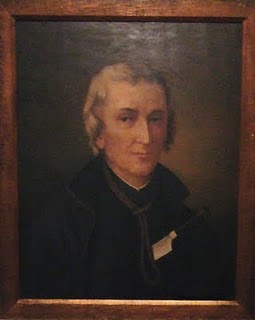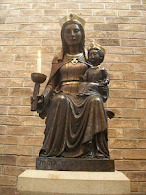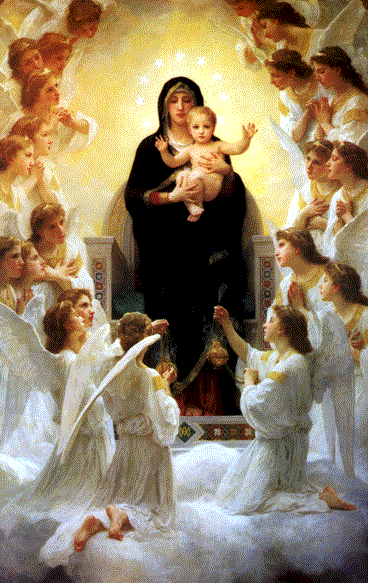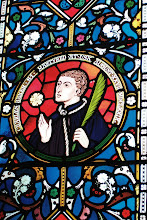 This interesting fragment of stone bears the inscription "DAVID LEWIS 1679". It was found in the churchyard of the Catholic Church in Usk but no one seems to know anything about its history. Knowledge of its age, origin, etc, seems to be lost in the mists of time. The stone, which has a small cross embedded in it, appears to be the remains of some sort of memorial to the martyred Welsh Jesuit. This stone may or may not be of any significance but, since the only purpose of this blog is to make St David Lewis better known, anything that has even a remote connection to our wonderful Saint is worth investigating, in so far as we are able. Not being professional historians or archaeologists, we are at a decided disadvantage. However, we are devoted to St David Lewis so we do our best with our limited talents. Whatever this curious artifact is, it must have a story and, important or not, it would be nice to know that story. Therefore, I am asking if anyone out there in Blog land has any knowledge of this object? I would be more than delighted to hear from you if you do. (FOR A BETTER VIEW OF THE STONE, CLICK ON THE PICTURE TO ENLARGE IT.)
This interesting fragment of stone bears the inscription "DAVID LEWIS 1679". It was found in the churchyard of the Catholic Church in Usk but no one seems to know anything about its history. Knowledge of its age, origin, etc, seems to be lost in the mists of time. The stone, which has a small cross embedded in it, appears to be the remains of some sort of memorial to the martyred Welsh Jesuit. This stone may or may not be of any significance but, since the only purpose of this blog is to make St David Lewis better known, anything that has even a remote connection to our wonderful Saint is worth investigating, in so far as we are able. Not being professional historians or archaeologists, we are at a decided disadvantage. However, we are devoted to St David Lewis so we do our best with our limited talents. Whatever this curious artifact is, it must have a story and, important or not, it would be nice to know that story. Therefore, I am asking if anyone out there in Blog land has any knowledge of this object? I would be more than delighted to hear from you if you do. (FOR A BETTER VIEW OF THE STONE, CLICK ON THE PICTURE TO ENLARGE IT.)Friday, 25 June 2010
CAN ANYONE SOLVE THE MYSTERY?
 This interesting fragment of stone bears the inscription "DAVID LEWIS 1679". It was found in the churchyard of the Catholic Church in Usk but no one seems to know anything about its history. Knowledge of its age, origin, etc, seems to be lost in the mists of time. The stone, which has a small cross embedded in it, appears to be the remains of some sort of memorial to the martyred Welsh Jesuit. This stone may or may not be of any significance but, since the only purpose of this blog is to make St David Lewis better known, anything that has even a remote connection to our wonderful Saint is worth investigating, in so far as we are able. Not being professional historians or archaeologists, we are at a decided disadvantage. However, we are devoted to St David Lewis so we do our best with our limited talents. Whatever this curious artifact is, it must have a story and, important or not, it would be nice to know that story. Therefore, I am asking if anyone out there in Blog land has any knowledge of this object? I would be more than delighted to hear from you if you do. (FOR A BETTER VIEW OF THE STONE, CLICK ON THE PICTURE TO ENLARGE IT.)
This interesting fragment of stone bears the inscription "DAVID LEWIS 1679". It was found in the churchyard of the Catholic Church in Usk but no one seems to know anything about its history. Knowledge of its age, origin, etc, seems to be lost in the mists of time. The stone, which has a small cross embedded in it, appears to be the remains of some sort of memorial to the martyred Welsh Jesuit. This stone may or may not be of any significance but, since the only purpose of this blog is to make St David Lewis better known, anything that has even a remote connection to our wonderful Saint is worth investigating, in so far as we are able. Not being professional historians or archaeologists, we are at a decided disadvantage. However, we are devoted to St David Lewis so we do our best with our limited talents. Whatever this curious artifact is, it must have a story and, important or not, it would be nice to know that story. Therefore, I am asking if anyone out there in Blog land has any knowledge of this object? I would be more than delighted to hear from you if you do. (FOR A BETTER VIEW OF THE STONE, CLICK ON THE PICTURE TO ENLARGE IT.)
Labels:
Catholic Church,
Gravestone,
Jesuit,
Marker,
Martyr,
Mystery,
ST DAVID LEWIS,
Stone,
Usk,
WELSH
Subscribe to:
Post Comments (Atom)








.JPG)

.JPG)






I wish I could help, but alas I cannot. But I will await the results of your queery. Your blog is so interesting. Thank you! Cathy
ReplyDeleteDoes the date have any significance in the Saint's life? The Cross denotes that he was already considered as a special person rather than just a priest, perhaps. The stone looks quite thick. Part of a building perhaps rather than a tomb stone or memorial stone.
ReplyDeleteJust a few clues from a clueless person.
God bless.
I love St. David Lewis and know much about him. However I do not know what this object is from. It has the date he died on it but perhaps this rock was from the prison he was in before he was executed or it could be from a memorial to him. Part of his gravestone?
ReplyDeleteHi Grandma K
ReplyDeleteEven if you can't help it is still great to hear from you. I appreciate your support and your comments are always welcome. I really hope someone out there can shed a little light on this stone. It would be interesting so keep watching. God bless you.
Hi Victor
ReplyDeleteIt is nice to hear from you. Yes the date is very significant! St David Lewis was martyred at Usk on 27th August 1679. You are right about the stone being thick and your other observations are also worth considering. Thanks, Victor, and if you have any other thoughts on it, please let me know. God bless you, Victor. (You are far from 'clueless'!)
Hello John
ReplyDeleteA very BIG WELCOME! I thought you had stopped blogging so I haven't been looking in to your blog recently. I am so glad you are back! I am also very glad that you love St David Lewis. I think he is wonderful too. He was born, worked and died in the area in which I live. I started this blog simply because St David Lewis is not terribly well known outside this area and I believe he deserves much more recognition than he gets. I really have no idea where the stone is from but I don't think it is from his gravestone as we have that. I suppose it could be from the old Gaol though. I thank you for your thoughts and, as I said to Victor, if you have anymore thoughts on it, please let me know. God bless you John.
Hey John
ReplyDeleteI forgot to say that if you have a look at the post for 18th October 2009, "A Must Visit", you will see a picture of what is generally believed to be the Saint's original gravestone. Our 'mystery stone' is not from that. Keep the ideas flowing though. God bless you.
Clueless? I didn't even see the date 1679 at the top of your Blog. How stupid is that?
ReplyDelete"D'OH" as Homer Simpson would say.
Here are some more silly questions?
Is Usk, where the stone was found in the locality where the priest lived/died? Is the stone itself from the locality? e.g. local quarries etc ...
It could be that the church in question had a memorial (monument) for the Saint. Hence the thickness of the stone. I note that it is quite "clean" and gives the impression of being relatively "new" - i.e. it does not date back to the death of the priest. Hence it could be a memorial with two dates on either side of the Cross. His death and the year he was made a Saint. Perhaps. Although, come to think of it, the area on the right of the Cross has not (yet) been engraved. So whoever built the intended monument either run out of funds and stopped the project, or had yet to engrave a date on the right of the Cross and somehow was prevented from doing so, or it was decided to use another stone because there was something wrong with this one ... See where all this is leading to? It may be an unfinished memorial. The stone appears to be nicely cut at the top and left hand side but unevenly broken elsewhere. Maybe it was a rejected stone because somehow it broke whilst being engraved.
Are there any other similar memorials in honour of St David? If so, are there of similar material?
I think by now you must be getting tired of my silly questions leading to nowhere. Sorry.
God bless.
Hi Victor
ReplyDeleteI am absolutely NOT TIRED of your questions because I don't think they are silly. I welcome your thoughts and suggestions because they could lead to some memory jogging or even to some positive results. So - keep the thoughts coming, please.
The stone was found in the churchyard of the Catholic Church in Usk. The church is on, or opposite, the site of the martyr's execution. The stone, in my opinion, is much later than 17th or 18th centuries. It could, as you suggest, be from an intended monument or a monument that fell into disrepair. The stone has a lovely little cross embedded in it so it was certainly intended to honour St David Lewis and I find it strange that no one, even the older residents of Usk, seems to know anything about it. After all, we all know about things we ourselves have never seen but have heard about them from older members of our parish, our family, or from local history. It is indeed a mystery but I still hope some scrap of information will turn up. In the meantime, Victor, please keep the thoughts coming. They are all worth considering and one never knows where they will lead. Thanks for your interest and God bless you.
OK ... one last shot at this then I'll leave you in peace.
ReplyDeleteThe obvious conclusion one would jump to is that we should engrave two dates on either side of the Cross. His date of canonisation perhaps?
NO.
This was in 1970 and by then people were well advanced in the art of engraving; and this sample is somewhat crude. Looks like someone using a sharp nail or knife rather than proper engraving.
So the second obvious conclusion is that the dates intended on either side of the Cross are 1616 and 1679 - birth and death; which is the more traditional way of engraving dates on monuments and tomb stones.
And the engraver made a mistake (too much vino perhaps) and put the wrong date on the left of the Cross.
"D'OH ..." said the engraver when he realised his mistake.
"Stupid boy ..." said his boss as he threw the stone away.
So there you have it. A simple solution from a simple mind. It is just an intended monument stone which was wrongly engraved and thrown aside only to be found again years later.
God bless.
Good Morning Victor
ReplyDeleteYou are very probably right! I have enjoyed your comments and I promise that if I ever find out any information about this stone, I WILL DEFINITELY LET YOU KNOW! Thanks Victor and God bless you.
Have you thought of asking a local monumental mason for an opinion?
ReplyDeleteHello Ttony
ReplyDeleteWelcome! It is nice to hear from you. Thank you for your very sensible suggestion. Guess what? We never thought of asking a monumental mason's opinion!!! We will have to look into that. Thanks again and God bless you.